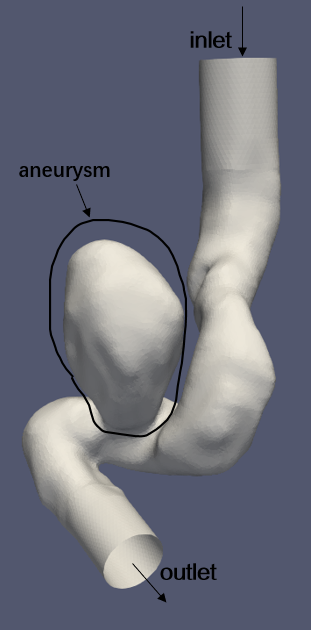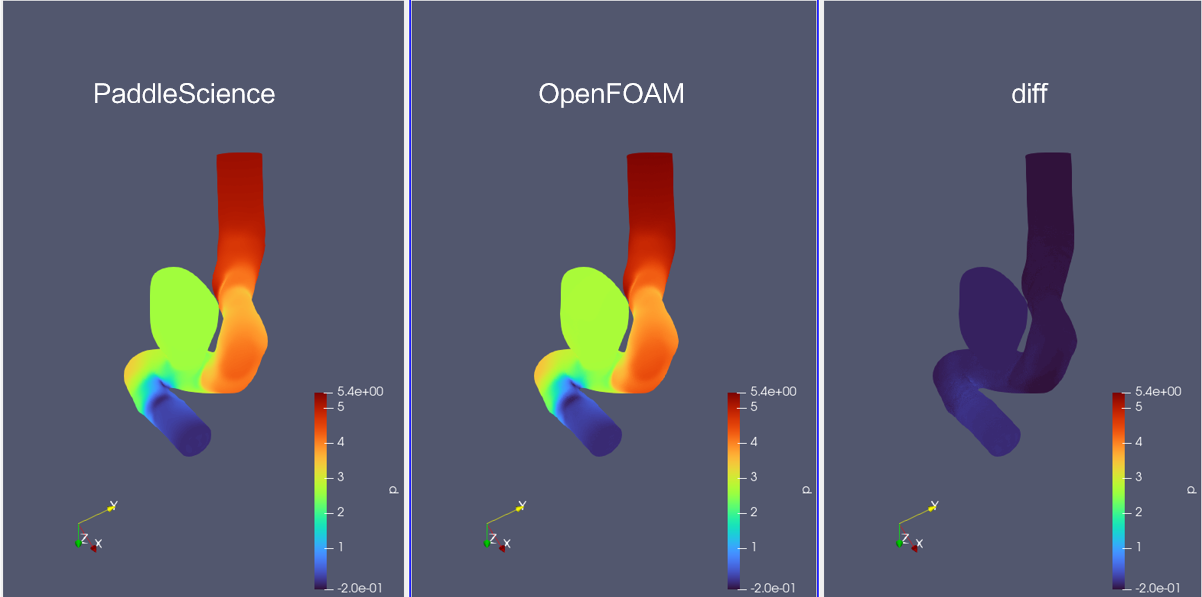Aneurysm¶
# linux
wget -nc https://paddle-org.bj.bcebos.com/paddlescience/datasets/aneurysm/aneurysm_dataset.tar
# windows
# curl https://paddle-org.bj.bcebos.com/paddlescience/datasets/aneurysm/aneurysm_dataset.tar --output aneurysm_dataset.tar
# unzip it
tar -xvf aneurysm_dataset.tar
python aneurysm.py mode=eval EVAL.pretrained_model_path=https://paddle-org.bj.bcebos.com/paddlescience/models/aneurysm/aneurysm_pretrained.pdparams
# linux
wget -nc https://paddle-org.bj.bcebos.com/paddlescience/datasets/aneurysm/aneurysm_dataset.tar
# windows
# curl https://paddle-org.bj.bcebos.com/paddlescience/datasets/aneurysm/aneurysm_dataset.tar --output aneurysm_dataset.tar
# unzip it
tar -xvf aneurysm_dataset.tar
python aneurysm.py mode=infer
| 预训练模型 | 指标 |
|---|---|
| aneurysm_pretrained.pdparams | loss(ref_u_v_w_p): 0.01488 MSE.p(ref_u_v_w_p): 0.01412 MSE.u(ref_u_v_w_p): 0.00021 MSE.v(ref_u_v_w_p): 0.00024 MSE.w(ref_u_v_w_p): 0.00032 |
1. 背景简介¶
深度学习方法可以用于处理血管瘤问题,其中包括基于物理信息的深度学习方法。这种方法可以用于脑血管瘤的压力建模,以预测和评估血管瘤破裂的风险。
针对如下血管瘤几何模型,本案例通过深度学习方式,在内部和边界施加适当的物理方程约束,以无监督学习的方式对管壁压力进行建模。
2. 问题定义¶
假设血管瘤模型中,在入口 inlet 部分,中心点的流速为 1.5,并向四周逐渐减小;在出口 outlet 区域,压力恒为 0;在边界上无滑移,流速为 0;血管内部则符合 N-S 方程运动规律,中间段的平均流量为负(流入),出口段的平均流量为正(流出)。
3. 问题求解¶
接下来开始讲解如何将问题一步一步地转化为 PaddleScience 代码,用深度学习的方法求解该问题。 为了快速理解 PaddleScience,接下来仅对模型构建、方程构建、计算域构建等关键步骤进行阐述,而其余细节请参考 API文档。
3.1 模型构建¶
在 aneurysm 问题中,每一个已知的坐标点 \((x, y, z)\) 都有对应的待求解的未知量 \((u, v, w, p)\)(速度和压力) ,在这里使用比较简单的 MLP(Multilayer Perceptron, 多层感知机) 来表示 \((x, y, z)\) 到 \((u, v, w, p)\) 的映射函数 \(f: \mathbb{R}^3 \to \mathbb{R}^4\) ,即:
上式中 \(f\) 即为 MLP 模型本身,用 PaddleScience 代码表示如下
为了在计算时,准确快速地访问具体变量的值,在这里指定网络模型的输入变量名是 ("x", "y", "z"),输出变量名是 ("u", "v", "w", "p"),这些命名与后续代码保持一致。
接着通过指定 MLP 的层数、神经元个数,就实例化出了一个拥有 6 层隐藏神经元,每层神经元数为 512 的神经网络模型 model,使用 silu 作为激活函数,并使用 WeightNorm 权重归一化。
3.2 方程构建¶
血管瘤模型涉及到 2 个方程,一是流体 N-S 方程,二是流量计算方程,因此使用 PaddleScience 内置的 NavierStokes 和 NormalDotVec 即可。
3.3 计算域构建¶
本问题的几何区域由 stl 文件指定,按照下方命令,下载并解压到 aneurysm/ 文件夹下。
注:数据集中的 stl 文件和测试集数据(使用OpenFOAM生成)均来自 Aneurysm - NVIDIA Modulus。
# linux
wget -nc https://paddle-org.bj.bcebos.com/paddlescience/datasets/aneurysm/aneurysm_dataset.tar
# windows
# curl https://paddle-org.bj.bcebos.com/paddlescience/datasets/aneurysm/aneurysm_dataset.tar --output aneurysm_dataset.tar
# unzip it
tar -xvf aneurysm_dataset.tar
解压完毕之后,aneurysm/stl 文件夹下即存放了计算域构建所需的 stl 几何文件。
注意
使用 Mesh 类之前,必须先按照安装使用文档,安装好 open3d、pysdf、PyMesh 3 个几何依赖包。
然后通过 PaddleScience 内置的 STL 几何类 Mesh 来读取、解析这些几何文件,并且通过布尔运算,组合出各个计算域,代码如下:
在此之后可以对几何域进行缩放和平移,以缩放输入数据的坐标范围,促进模型训练收敛。
3.4 约束构建¶
本案例共涉及到 6 个约束,在具体约束构建之前,可以先构建数据读取配置,以便后续构建多个约束时复用该配置。
3.4.1 内部点约束¶
以作用在内部点上的 InteriorConstraint 为例,代码如下:
InteriorConstraint 的第一个参数是方程(组)表达式,用于描述如何计算约束目标,此处填入在 3.2 方程构建 章节中实例化好的 equation["NavierStokes"].equations;
第二个参数是约束变量的目标值,在本问题中希望与 N-S 方程相关的四个值 continuity, momentum_x, momentum_y, momentum_z 均被优化至 0;
第三个参数是约束方程作用的计算域,此处填入在 3.3 计算域构建 章节实例化好的 geom["interior_geo"] 即可;
第四个参数是在计算域上的采样配置,此处设置 batch_size 为 6000。
第五个参数是损失函数,此处选用常用的 MSE 函数,且 reduction 设置为 "sum",即会将参与计算的所有数据点产生的损失项求和;
第六个参数是约束条件的名字,需要给每一个约束条件命名,方便后续对其索引。此处命名为 "interior" 即可。
3.4.2 边界约束¶
接着需要对血管入口、出口、血管壁这三个表面施加约束,包括入口速度约束、出口压力约束、血管壁无滑移约束。
在 bc_inlet 约束中,入口处的流速满足从中心点开始向周围呈二次抛物线衰减,此处使用抛物线函数表示速度随着远离圆心而衰减,再将其作为 BoundaryConstraint 的第二个参数(字典)的 value。
血管出口、血管壁的无滑移约束构建方法类似,如下所示:
3.4.3 积分边界约束¶
对于血管入口下方的一段区域和出口区域(面),需额外施加流入和流出的流量约束,由于流量计算涉及到具体面积,因此需要使用离散积分的方式进行计算,这些过程已经内置在了 IntegralConstraint 这一约束条件中。如下所示:
对应的流量计算公式:
其中\(M\)表示离散积分点个数,\(s_i\)表示某一个点的(近似)面积,\(\mathbf{u_i}\)表示某一个点的速度矢量,\(\mathbf{n_i}\)表示某一个点的外法向矢量。
除前面章节所述的共同参数外,此处额外增加了 integral_batch_size 参数,这表示用于离散积分的采样点数量,此处使用 310 个离散点来近似积分计算;同时指定损失函数为 IntegralLoss,表示计算损失所用的最终预测值由多个离散点近似积分,再与标签值计算损失。
在微分方程约束、边界约束、初值约束构建完毕之后,以刚才的命名为关键字,封装到一个字典中,方便后续访问。
3.5 超参数设定¶
接下来需要指定训练轮数和学习率,此处按实验经验,使用 1500 轮训练轮数,0.001 的初始学习率。
3.6 优化器构建¶
训练过程会调用优化器来更新模型参数,此处选择较为常用的 Adam 优化器,并配合使用机器学习中常用的 ExponentialDecay 学习率调整策略。
3.7 评估器构建¶
在训练过程中通常会按一定轮数间隔,用验证集(测试集)评估当前模型的训练情况,因此使用 ppsci.validate.GeometryValidator 构建评估器。
3.8 可视化器构建¶
在模型评估时,如果评估结果是可以可视化的数据,可以选择合适的可视化器来对输出结果进行可视化。
本文中的输出数据是一个区域内的三维点集,因此只需要将评估的输出数据保存成 vtu格式 文件,最后用可视化软件打开查看即可。代码如下:
3.9 模型训练、评估与可视化¶
完成上述设置之后,只需要将上述实例化的对象按顺序传递给 ppsci.solver.Solver,然后启动训练、评估、可视化。
4. 完整代码¶
| aneurysm.py | |
|---|---|
1 2 3 4 5 6 7 8 9 10 11 12 13 14 15 16 17 18 19 20 21 22 23 24 25 26 27 28 29 30 31 32 33 34 35 36 37 38 39 40 41 42 43 44 45 46 47 48 49 50 51 52 53 54 55 56 57 58 59 60 61 62 63 64 65 66 67 68 69 70 71 72 73 74 75 76 77 78 79 80 81 82 83 84 85 86 87 88 89 90 91 92 93 94 95 96 97 98 99 100 101 102 103 104 105 106 107 108 109 110 111 112 113 114 115 116 117 118 119 120 121 122 123 124 125 126 127 128 129 130 131 132 133 134 135 136 137 138 139 140 141 142 143 144 145 146 147 148 149 150 151 152 153 154 155 156 157 158 159 160 161 162 163 164 165 166 167 168 169 170 171 172 173 174 175 176 177 178 179 180 181 182 183 184 185 186 187 188 189 190 191 192 193 194 195 196 197 198 199 200 201 202 203 204 205 206 207 208 209 210 211 212 213 214 215 216 217 218 219 220 221 222 223 224 225 226 227 228 229 230 231 232 233 234 235 236 237 238 239 240 241 242 243 244 245 246 247 248 249 250 251 252 253 254 255 256 257 258 259 260 261 262 263 264 265 266 267 268 269 270 271 272 273 274 275 276 277 278 279 280 281 282 283 284 285 286 287 288 289 290 291 292 293 294 295 296 297 298 299 300 301 302 303 304 305 306 307 308 309 310 311 312 313 314 315 316 317 318 319 320 321 322 323 324 325 326 327 328 329 330 331 332 333 334 335 336 337 338 339 340 341 342 343 344 345 346 347 348 349 350 351 352 353 354 355 356 357 358 359 360 361 362 363 364 365 366 367 368 369 370 371 372 373 374 375 376 377 378 379 380 381 382 383 384 385 386 387 388 389 390 391 392 393 394 395 396 397 398 399 400 401 402 403 404 405 406 407 408 409 | |
5. 结果展示¶
对于血管瘤测试集(共 2,962,708 个三维坐标点),模型预测结果如下所示。
可以看到对于管壁压力\(p(x,y,z)\),模型的预测结果和 OpenFOAM 结果基本一致。

